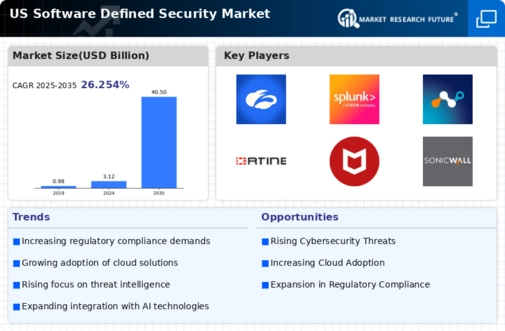-
EXECUTIVE SUMMARY
-
Market Overview
-
Key Findings
-
Market Segmentation
-
Competitive Landscape
-
Challenges and Opportunities
-
Future Outlook
-
MARKET INTRODUCTION
-
Definition
-
Scope of the study
-
Research Objective
-
Assumption
-
Limitations
-
RESEARCH METHODOLOGY
-
Overview
-
Data Mining
-
Secondary Research
-
Primary Research
-
Primary Interviews and Information Gathering Process
-
Breakdown of Primary Respondents
-
Forecasting Model
-
Market Size Estimation
-
Bottom-Up Approach
-
Top-Down Approach
-
Data Triangulation
-
Validation
-
MARKET DYNAMICS
-
Overview
-
Drivers
-
Restraints
-
Opportunities
-
MARKET FACTOR ANALYSIS
-
Value chain Analysis
-
Porter's Five Forces Analysis
-
Bargaining Power of Suppliers
-
Bargaining Power of Buyers
-
Threat of New Entrants
-
Threat of Substitutes
-
Intensity of Rivalry
-
COVID-19 Impact Analysis
-
Market Impact Analysis
-
Regional Impact
-
Opportunity and Threat Analysis
-
US Software Defined Security Market, BY Component (USD Billion)
-
Solutions
-
Services
-
US Software Defined Security Market, BY Enforcement Point (USD Billion)
-
Network Security Gateway
-
Others
-
US Software Defined Security Market, BY Deployment Mode (USD Billion)
-
Cloud
-
On-Premise
-
US Software Defined Security Market, BY End-Users (USD Billion)
-
Telecom
-
Cloud Service Providers
-
Competitive Landscape
-
Overview
-
Competitive Analysis
-
Market share Analysis
-
Major Growth Strategy in the Software Defined Security Market
-
Competitive Benchmarking
-
Leading Players in Terms of Number of Developments in the Software Defined Security Market
-
Key developments and growth strategies
-
New Product Launch/Service Deployment
-
Merger & Acquisitions
-
Joint Ventures
-
Major Players Financial Matrix
-
Sales and Operating Income
-
Major Players R&D Expenditure. 2023
-
Company Profiles
-
Zscaler
-
Financial Overview
-
Products Offered
-
Key Developments
-
SWOT Analysis
-
Key Strategies
-
VMware
-
Financial Overview
-
Products Offered
-
Key Developments
-
SWOT Analysis
-
Key Strategies
-
Splunk
-
Financial Overview
-
Products Offered
-
Key Developments
-
SWOT Analysis
-
Key Strategies
-
Netskope
-
Financial Overview
-
Products Offered
-
Key Developments
-
SWOT Analysis
-
Key Strategies
-
Fortinet
-
Financial Overview
-
Products Offered
-
Key Developments
-
SWOT Analysis
-
Key Strategies
-
McAfee
-
Financial Overview
-
Products Offered
-
Key Developments
-
SWOT Analysis
-
Key Strategies
-
SonicWall
-
Financial Overview
-
Products Offered
-
Key Developments
-
SWOT Analysis
-
Key Strategies
-
IBM
-
Financial Overview
-
Products Offered
-
Key Developments
-
SWOT Analysis
-
Key Strategies
-
Tenable
-
Financial Overview
-
Products Offered
-
Key Developments
-
SWOT Analysis
-
Key Strategies
-
Microsoft
-
Financial Overview
-
Products Offered
-
Key Developments
-
SWOT Analysis
-
Key Strategies
-
CrowdStrike
-
Financial Overview
-
Products Offered
-
Key Developments
-
SWOT Analysis
-
Key Strategies
-
Proofpoint
-
Financial Overview
-
Products Offered
-
Key Developments
-
SWOT Analysis
-
Key Strategies
-
Palo Alto Networks
-
Financial Overview
-
Products Offered
-
Key Developments
-
SWOT Analysis
-
Key Strategies
-
Cisco Systems
-
Financial Overview
-
Products Offered
-
Key Developments
-
SWOT Analysis
-
Key Strategies
-
Check Point Software Technologies
-
Financial Overview
-
Products Offered
-
Key Developments
-
SWOT Analysis
-
Key Strategies
-
References
-
Related Reports
-
US Software Defined Security Market SIZE ESTIMATES & FORECAST, BY COMPONENT, 2019-2035 (USD Billions)
-
US Software Defined Security Market SIZE ESTIMATES & FORECAST, BY ENFORCEMENT POINT, 2019-2035 (USD Billions)
-
US Software Defined Security Market SIZE ESTIMATES & FORECAST, BY DEPLOYMENT MODE, 2019-2035 (USD Billions)
-
US Software Defined Security Market SIZE ESTIMATES & FORECAST, BY END-USERS, 2019-2035 (USD Billions)
-
PRODUCT LAUNCH/PRODUCT DEVELOPMENT/APPROVAL
-
ACQUISITION/PARTNERSHIP
-
MARKET SYNOPSIS
-
US SOFTWARE DEFINED SECURITY MARKET ANALYSIS BY COMPONENT
-
US SOFTWARE DEFINED SECURITY MARKET ANALYSIS BY ENFORCEMENT POINT
-
US SOFTWARE DEFINED SECURITY MARKET ANALYSIS BY DEPLOYMENT MODE
-
US SOFTWARE DEFINED SECURITY MARKET ANALYSIS BY END-USERS
-
KEY BUYING CRITERIA OF SOFTWARE DEFINED SECURITY MARKET
-
RESEARCH PROCESS OF MRFR
-
DRO ANALYSIS OF SOFTWARE DEFINED SECURITY MARKET
-
DRIVERS IMPACT ANALYSIS: SOFTWARE DEFINED SECURITY MARKET
-
RESTRAINTS IMPACT ANALYSIS: SOFTWARE DEFINED SECURITY MARKET
-
SUPPLY / VALUE CHAIN: SOFTWARE DEFINED SECURITY MARKET
-
SOFTWARE DEFINED SECURITY MARKET, BY COMPONENT, 2025 (% SHARE)
-
SOFTWARE DEFINED SECURITY MARKET, BY COMPONENT, 2019 TO 2035 (USD Billions)
-
SOFTWARE DEFINED SECURITY MARKET, BY ENFORCEMENT POINT, 2025 (% SHARE)
-
SOFTWARE DEFINED SECURITY MARKET, BY ENFORCEMENT POINT, 2019 TO 2035 (USD Billions)
-
SOFTWARE DEFINED SECURITY MARKET, BY DEPLOYMENT MODE, 2025 (% SHARE)
-
SOFTWARE DEFINED SECURITY MARKET, BY DEPLOYMENT MODE, 2019 TO 2035 (USD Billions)
-
SOFTWARE DEFINED SECURITY MARKET, BY END-USERS, 2025 (% SHARE)
-
SOFTWARE DEFINED SECURITY MARKET, BY END-USERS, 2019 TO 2035 (USD Billions)
-
BENCHMARKING OF MAJOR COMPETITORS














